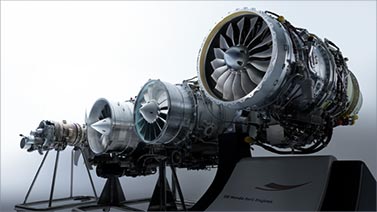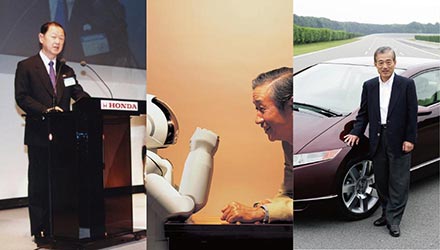Commercialization, Thought to be Impossible,
at the Final Stage
“We’ve come this far; we should see it through to market.”
Having successfully completed a battery of flight tests and demonstrated the HondaJet’s performance potential, the development team naturally clamored to bring it to market. However, they also understood the major investment that would be required for the company to get into the aircraft business, not to mention the risks involved. Even if the HondaJet’s performance was outstanding, could an all-new business jet created by a Japanese carmaker really sell? Even inside Honda, most people thought that getting such a business off the ground was nearly impossible. In fact, many people assumed that once the POC HondaJet had completed its test flights, all research and development would simply come to an end.
It was amidst these growing concerns that approval was given to exhibit the POC HondaJet at the upcoming July, 2005 Oshkosh Air Show. Held every year in Oshkosh, Wisconsin, Oshkosh is the largest air show in the world, and attracts nearly 600,000 visitors annually. It’s also a place where business jet manufacturers regularly announce their new products. Naturally, the development team was elated to go, but they also had some mixed feelings about it. Approval to go to Oshkosh felt a little like they’d received approval to deliver a final eulogy on the company’s many years of aircraft research. Yes, it could be considered a reward for their long years of effort, but a reward that might be seen as marking the end of the project. They feared that exhibiting at Oshkosh might end up being both the first and last showcase for Honda’s aircraft research.
On the day of the air show, the HondaJet circled over the venue, landed on the runway, and taxied up to Honda’s designated parking spot. Nobody had any idea what would happen next - which was that over a thousand aviation fans immediately surrounded the HondaJet with massive cheers and applause. The excitement was infectious, and the speech that introduced the main features of the new aircraft was constantly peppered by shouts of encouragement. Some people even claimed that it was the most beautiful plane they’d ever seen!

HondaJet display at the Oshkosh Air Show drew praise from aviation enthusiasts
The Long-Anticipated “Someday” Finally Arrives
Having enjoyed such a stunning debut at the Oshkosh Air Show, the tide began to turn for the HondaJet as people both inside and outside the company began to recognize its value and potential. One person even sent a $50,000 check directly to Honda with the message, “I want to buy one!”
However, getting approval to commercialize the HondaJet still wasn’t going to be easy. Although the development team made several proposals, management continued to put off the issue of becoming a full-fledged aircraft manufacturer. Among many difficulties, they knew that selling an aircraft would require significant new investments in things like pilot training and aftermarket maintenance, which would require its own specialized training and staffing. Honda would have to commit to making aircraft manufacturing a long-term business, and would have to be prepared - in all aspects - to follow through with full support, whatever the cost.
That day did finally come, though. In March of 2006, after a long period of relative silence, President Takeo Fukui finally approved the commercialization of the HondaJet. After all these years, the development team could hardly believe it. They’d been hoping to get the go-ahead for such a long time, but they also understood the difficulties involved in moving into such a business. In fact, it should be noted that top management’s decision to commit to marketing the Honda aircraft arguably required even more courage than the development team needed to make their numerous proposals.
In any case, it was a joyous day for the aircraft development team, though by the next morning they were already putting their celebrations behind them and working feverishly to put together the many pieces they’d need in place in a few short months, when they’d officially be putting the new aircraft on the market.
A Carmaker’s Attention to Detail
From Honda’s perspective, many of the small business jets on the market seemed to lack the attention to detail that had become second nature to Honda over its decades as a carmaker. Many had cramped cabins. Most had cockpits comprised of little more than flat panels packed with aviation instrumentation. Sometimes drops of condensation would fall from their ceilings as the outside temperatures dropped. And they were so noisy inside - surely there must be a way to make the cabin as quiet as a typical passenger car. In other words, there seemed to be quite a lot of room for improvement in the small business jet market.
In many respects the HondaJet had already set itself apart from existing small business jets. Its nose and wings were all beautifully designed with a natural laminar flow that effectively reduced aerodynamic drag. Its exterior appearance and composite fuselage were almost completely uncluttered by bumps and unevenness in its surface finish. Its interior was as beautiful as a luxury sedan, including a spacious cockpit with a wide-field windshield and a next-generation all-glass avionics system.*2 Even when taxiing, the HondaJet’s steering and braking felt more like a car, and its quiet interior was unlike any other business jet that had come before.
Honda was able to realize these unprecedented features because the HondaJet’s development process was so greatly influenced by the design know-how and aesthetic sensibilities that it had built up over its many decades as a carmaker. While automobile companies generally released new model designs every four years or so, aircraft manufacturers changed their models only rarely. This translated to major differences in their approach to development, and it was from this carmaker’s perspective that the development team focused on adding further value to the HondaJet.
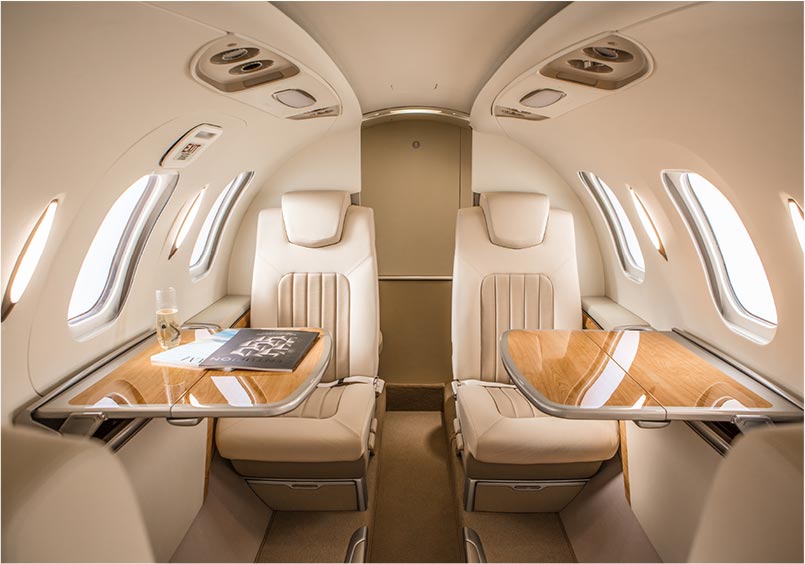
The HondaJet Elite cabin, designed for comfort
Equally impressive was the HondaJet’s actual performance. A pilot seated in its comfortable cockpit could expect the plane to ascend at a class-leading rate of 4,000 feet (1,220 m) per minute. And while other aircraft in this class might barely reach 41,000 feet (12,500 m), the HondaJet could climb smoothly to 43,000 feet (13,100 m), giving it easy access to the less congested airspace at higher altitudes. And with a cruising speed of 420 knots (778 km/h), it was also fast.
If one were to describe the HondaJet in automotive terms, it would be a compact car offering the luxurious ride of a Honda Legend and the handling and maneuverability of the NSX - not to mention the best fuel economy in its class. So it’s really no wonder that the HondaJet was so highly acclaimed. Also, while color design had never before been considered an important feature in the world of small business jets, the HondaJet’s color schemes were meticulously thought out as yet another way to express the profound functional beauty and peerless aerodynamic design of its fuselage, and the HondaJet overall. In these ways almost everything about the HondaJet went above and beyond what was conventionally expected of a small business jet.
- “Avionics” refers to the electronic equipment installed in aircraft and used for flight monitoring and control.

Cockpit with advanced avionics (HondaJet Elite)
Orders Finally Start to Arrive
In 2006, Honda established the Honda Aircraft Company (HACI), a U.S. subsidiary tasked with developing, manufacturing, and marketing the company’s aircraft. The first orders would come at that year’s National Business Aviation Association (NBAA) Air Show, where Honda planned to officially begin selling the HondaJet. Most of the development team didn’t get much sleep the night before, because they were worried about all the possible “What-ifs...”: “What if nobody wants it...?” “What if we don't sell a single airplane...?” “What if...?!”
Fortunately these worries proved unfounded. On October 17, 2006, Honda held a press conference to officially announce that it would start taking orders for the HondaJet. Several hundred people crowded into the conference space, and the Honda booth outside was also abuzz with an energy and enthusiasm that immediately set it apart from most of the other booths. As soon as the press conference was finished the order-taking began, and on the first day alone the Honda Aircraft Company received orders for more than 100 HondaJets. It was truly incredible and completely unprecedented to see new customers lining up and waiting their turn to buy a business jet.
HondaJet salespeople, customers, media reporters, and members of the development team were all running around the venue for the entire day, all feeling the excitement that the stylish new small jet was generating. Some attendees were so impressed with the novelty of the cabin mockups on display that they signed contracts on the spot. As one guest put it, “the HondaJet was selling like hotcakes” and he’d never seen anything like it in twenty years of attending the NBAA air show.
2.4 Million Pages of Documentation for Type certification

Honda independently received type certification
Due to their understandably strict regulations, no aircraft can be delivered to any customer without having first obtained type certification from the U.S. Federal Aviation Administration (FAA). The type certification process requires an unimaginable amount of paperwork, detail, and patience, and FAA approval must be earned every step of the way. For example, the process begins with determining what certification standards should be used, how and when the aircraft must be certified, what testing will be conducted, and what the plan is for every component and for the overall aircraft design.
This initial inquiry is followed by a long battery of certification tests, both for individual components and for the aircraft as a whole, and then finally flight testing. Even the flight plan itself must be submitted to the FAA for approval before testing can begin. Once the flight plan is approved, an FAA department separate from the flight test checks and approves every single screw and bolt to ensure that the aircraft used for the flight test is exactly as specified in the design schematics. Only after that approval is obtained can flight testing by certified FAA pilots begin. Following the flight testing, the aircraft is again thoroughly evaluated, the flight manual is approved, and only then is type certification finally granted.
Over 2.4 million pages of documentation were submitted to the FAA by the development team in order to obtain HondaJet type certification. Compare this to the number of pages in your average encyclopedia, which might have several thousand pages, and you can start to imagine the sheer volume of documentation required. On December 8, 2015, Honda finally obtained type certification for the HondaJet, and both the company’s success in doing so and the tremendous effort put into it would prove invaluable not only for Honda, but also for Japan and other newcomers to the market.
The HondaJet Takes Best-in-Category in Just Two Years
Much like obtaining type certification, establishing a production and service system for the new airplane was no easy task. It was vitally important to provide high-quality service worthy of the Honda name, and thus earn the ongoing confidence of its customers even after they’d taken delivery of their HondaJet.
The first long-awaited deliveries took place on December 23, 2015 in the United States, then in Europe in 2016, and thereafter the HondaJet took off around the world. After logging record-breaking deliveries for the entire year of 2017, the HondaJet topped the list for five consecutive years through 2021 and continues to gain in popularity.
The HondaJet continued to evolve as product over time. In May 2018, the HondaJet Elite was released, offering a longer range and high-frequency engine noise reduction for an even quieter cabin. In May 2021, Honda announced an improved model, the HondaJet Elite S. On October 17,2022, Honda announced the latest model, the HondaJet Elite II, equipped with extended fuel tanks and increased maximum takeoff weight, boosting its range to 1,547 nautical miles (2,865 km), or 110 nautical miles*3 (204 km) over the HondaJet Elite. This aircraft was also the first to be equipped with wing-integrated ground spoilers to assist with post-landing deceleration, and by 2023 it also newly featured advanced automation technologies, like auto-throttle, to further reduce pilot workload, as well as emergency landing gear.
- A nautical mile is a unit of distance equivalent to one minute of latitude on the surface of the earth, equivalent to approximately 1.15 land miles, or 1,852 meters.
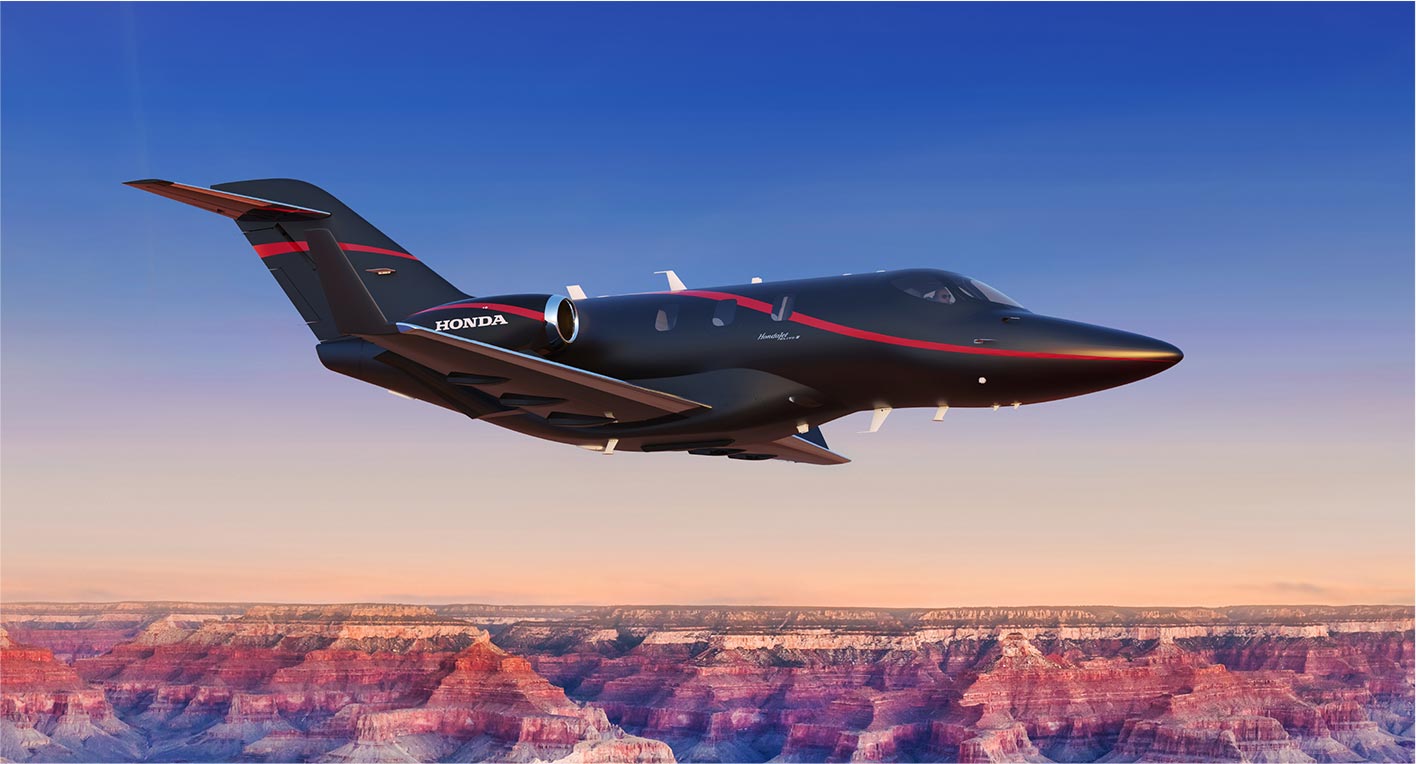
HondaJet Elite II announced in 2022
Developing a Small Business Jet Capable of Nonstop
Transcontinental U.S. Flights
In 2021, the HondaJet 2600 Concept was unveiled as a reference exhibit at the NBAA Business Aircraft Show held in Las Vegas, Nevada, as a small business jet concept aircraft that would bring new value to mobility. The presentation was met with high acclaim from customers, convincing Honda of a strong demand in the market, leading to its decision to commercialize the aircraft in June 2023. The new model would enter the light jet*4 category, one class higher than previous HondaJets.
The new small business jet would be designed to be capable of carrying up to 11 passengers and crew, by further evolving Honda’s proprietary technologies such as over-the-wing engine mounting, natural laminar flow wing and nose design, and a composite fuselage. In addition, by improving fuel efficiency by 20% compared to conventional light jets and by more than 40% compared to mid-size jets*5, the HondaJet 2600 aimed to become the world’s first light jet with a cruise range long enough to make a nonstop flight across the continental United States.
The decision was made to develop the new model based on the HondaJet 2600 Concept, aiming to obtain FAA type certification around 2028.
In 2006, nearly twenty years after initial research began, Honda made the momentous decision to enter the aircraft market. Within twenty-nine years from that initial start, the company obtained certification for the HondaJet and began deliveries. Since then, Honda has continued to develop its innovative aircraft business, and the HondaJet continues to evolve, always pursuing the dream of expanding mobility into the sky and extending the joy of flight to ever greater numbers of people.
- Twin-engine aircraft with a maximum takeoff weight of 12,500 lbs. to less than 20,000 lbs. One class above HondaJet Elite II (Very Light Jet-class)
- Twin-engine aircraft with a maximum takeoff weight of 20,000 lbs.to less than 35,000 lbs.
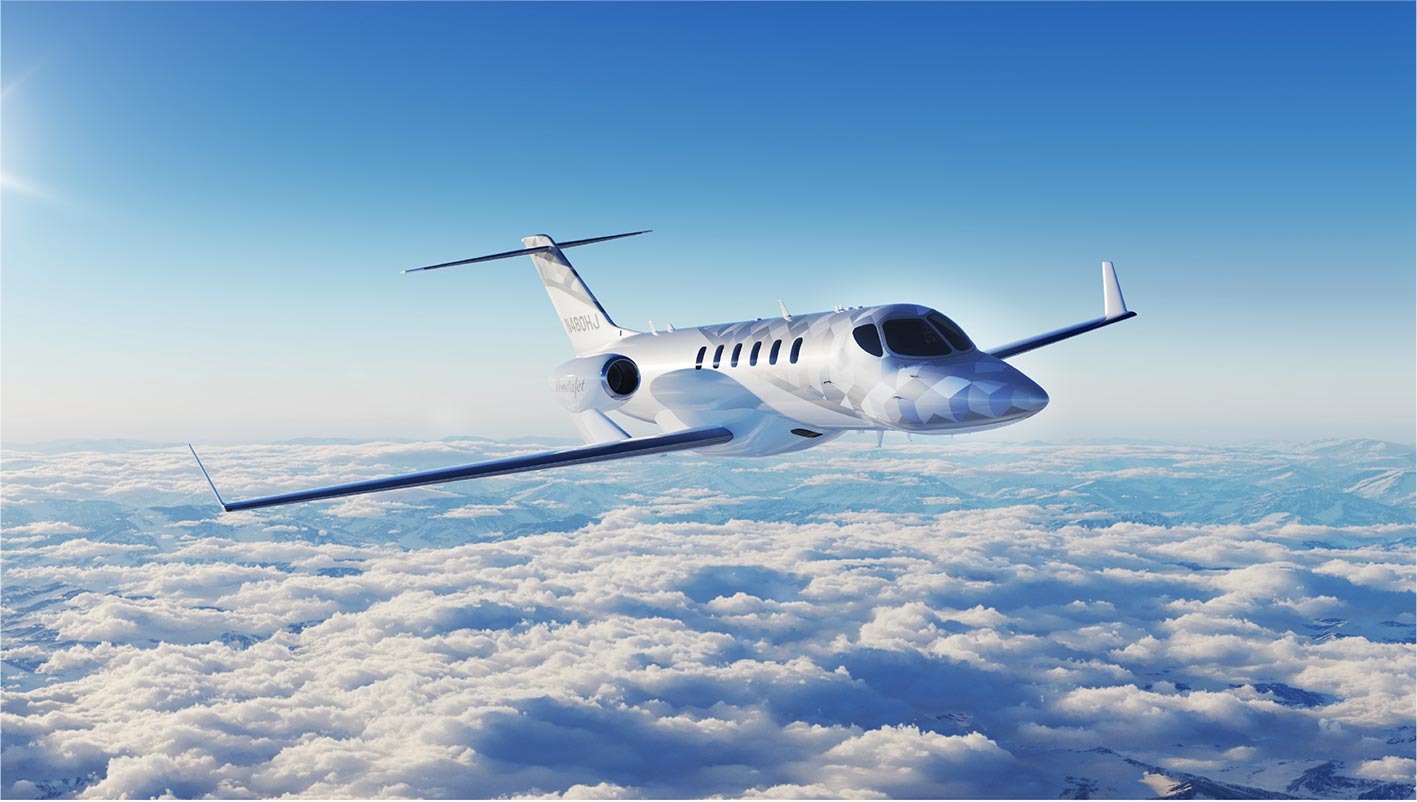
HondaJet 2600 Concept to receive FAA type certification in 2028

